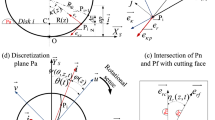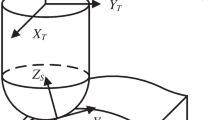Abstract
The purpose of this paper is to provide a reasonable means to approach tool shape optimization of ball end mill for high-speed milling operation. The paper presents a new development of an integrated system for ball end mill design, creation and evaluation that is more flexible and more systematic than the commercially available tool fabrication systems.
The study consists of three major contents: (1) 3D-CAD/CAM system development for ball end mill design and creation, (2) fundamental investigations of cutting characteristics with different ball end mills, and (3) improvement of tool life and machining stabilization for high-speed milling by means of new tool shape proposals. These are explained in the following sections, respectively. Through the above developments and investigations, it is evidently found that the developed system shows great validity and possibility to realize tool shape optimization of the ball end mill.
Similar content being viewed by others
References
Altan T (1993) Advanced techniques for die and mold manufacturing. Ann CIRP 42(2):707–716
Gaida W, Rodriguez C, Altan T, Altintas Y (1995) Preliminary experiments for adaptive finish milling of die and mold surfaces with ball-nose end mills. Trans NAMRI/SME 23:193–198
Heisel U, Gringel M (1997) Machine tool design requirements for high- speed machining. Ann CIRP 46(1):389–392
Tsutsumi M, Saito A (2003) Identification and compensation of systematic deviations particular to 5-axis machining centers. Int J Mach Tools Manuf 43:629636
Weck M, Schubert I (1994) New interface machine/tool: hollow shank. Ann CIRP 43(1):345–348
Rivin E (2000) Tooling structure: interface between cutting edge and machine tool. Ann CIRP 49(2):591–634
Schulz H, Moriwaki T (1992) High-speed machining. Ann CIRP 41(2):637–643
Schulz H, Hock S (1995) High-speed milling of die and molds – cutting conditions and technology. Ann CIRP 44(1):35–38
Takahashi I, Anzai M, Nakagawa T (1999) Wear characteristics of small WC ball end mill at 100 000/min milling. J JSPE 65(5):867
Dewes RC, Aspinwall DK (1997) A review of ultra high-speed milling of hardened steels. J Mater Process Technol 69:1–17
Vichers G, Quan K (1989) Ball-mills versus end-mills for curved surfaces milling. ASME J Eng Ind 111:22–26
Takeuchi Y, Nagasaka M, Morishige K (1996) 5-axis control machining with top and side cutting edges of ball end mill. J Adv Autom Technol 8(1):30–36
Choi B, Jun C (1989) Ball-end cutter interference avoidance in NC machining of sculptured surfaces. Comput Aided Des 21(6):371–378
Takeuchi Y, Watanabe T (1992) Generation of five-axis control collision-free tool path and post processing for NC data. Ann CIRP 41(1):539–542
Nagasaka M, Takeuchi Y (1996) Generalized post-processor for 5-axis control machining based on form shape function. J JSPE 62(11):1607–1611
Author information
Authors and Affiliations
Corresponding author
Rights and permissions
About this article
Cite this article
Lu, Y., Takeuchi, Y., Takahashi, I. et al. An integrated system development for ball end mill design, creation and evaluation. Int J Adv Manuf Technol 25, 628–646 (2005). https://doi.org/10.1007/s00170-004-2259-4
Received:
Accepted:
Published:
Issue Date:
DOI: https://doi.org/10.1007/s00170-004-2259-4




